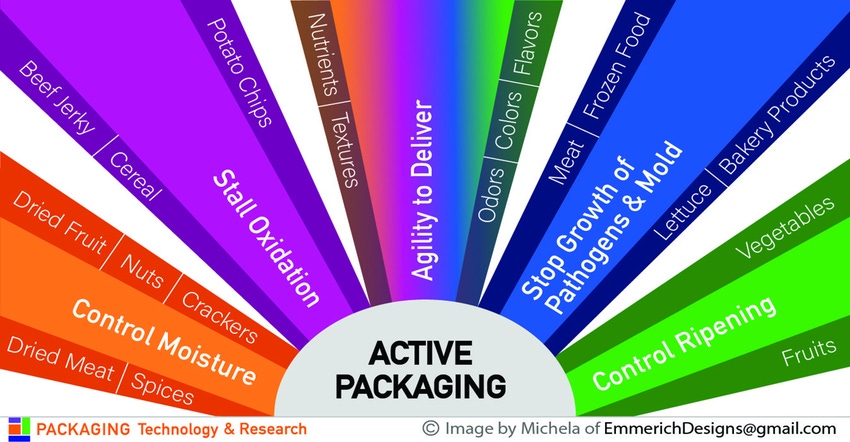Food packaging expert Claire Sand identifies four old reasons and one new reason — agility — why this proven technology will continue to thrive.
November 23, 2020

With the healthy-lifestyle-inspired decline in food preservatives along with lengthened supply chains, active packaging is working harder to keep food fresh and safe for consumers.
But before we dive in, a little terminology lesson is in order because active packaging and intelligent packaging are often confused. The difference is that active packaging acts, whereas intelligent packaging communicates (to consumers and others throughout the value chain).
Active packaging can stall oxidation, control ripening, and stop microbial growth as well as moisture loss or gain more effectively than traditional packaging. We usually associate active packaging with vacuum or gas flushing with a modified atmosphere within a high barrier package. This is a type of active packaging and is one of five categories to keep in mind.
1. Active packaging stalls oxidation.
Products with unsaturated fats such as nuts, potato chips, beer, and beef jerky can oxidize in the presence of oxygen. Residual oxygen in the product or package headspace can be absorbed using Iron or Vitamin C embedded within sachets or added from master-batches to polyethylene (PE), polypropylene (PP), and PET films and rigid containers.
Jack Links, Wild West, and Cattleman’s Cut branded beef jerky use oxygen scavengers to reduce oxidation and mold growth. Carlsberg extends beer-life by 15% using oxygen-absorbing liners in FreshCap closures. Active packaging Antioxidants, BHT and BHT and a-tocopherols, migrate into the package headspace to inhibit oxidation. Another Active Packaging technology is BreatheWay, which vents the putrid smell of oxidation by-products.
2. Active packaging controls produce ripening.
Ethylene scavengers extend the shelf life of produce by slowing the ripening process. 1-methlcyclopropene (1-MCP) blocks ethylene receptors, and slow ripening is a common wash used for fruits and vegetables. Using this compound within active packaging helps control ripening during distribution.
FruitBrite active packaging by Hazel Technologies releases 1-MCP to diffuse ethylene blockers within the headspace of Packaging during distribution. And corrugated linerboard infused with 1-MCP allows for more seamless and consistent produce distribution without sachets. Other ethylene scavenging active packaging technologies exist.
3. Active packaging stops pathogen and mold growth.
Naturally derived active packaging can inhibit the growth of mold and pathogens. Nano-sized zinc is Generally Recognized as Safe (GRAS) by the FDA and is effective against pathogens such as Listeria monocytogenes, Salmonella, and Escherichia coli. It can be incorporated into the paperboard and plastic-based layers in direct contact with food. The protein Nisin is another effective active packaging coating against Listeria, Bacillus cereus, and Staphylococcus aureus. Essential Oils of Oregano and Grapefruit Seed Extract inhibit E.coli and Listeria. These and other essential oils are either added as a food contact layer or used in place of plasticizers to inhibit microbial growth. Short carbon chain length oils such as Caprylic, Capric, and Lauric are used in many active packaging applications, including the Apeel technology, inhibit mold growth on fruits and vegetables.
4. Active packaging regulates moisture.
For some food such as drink mixes and spices, moisture needs to be maintained at a low level, and for other foods such as raisins, moisture needs to remain higher. Moisture-regulating active packaging keeps moisture at the level needed. This includes films embedded with silica gel desiccants, activated clay, minerals, and superabsorbent polymers to ensure the package headspace remains dry. Active packaging to maintain moisture in dried fruits includes edible coatings and hydrogels.
5. The new reason: Active packaging delivers agility.
As active packaging enters the mainstream packaging to protect brand integrity and extend food shelf life, even more innovation and application are possible. This technology is increasingly refined. Active packaging technology is on the cusp of enabling personalization of food just-before-eating and manufacturing agility using packaging to deliver nutrients, flavors, odors, textures, and colors in response to environmental conditions, time, or consumer interaction.
Claire Sand, PhD, has 30+ years of experience in industry and academia. She's owner of Packaging Technology and Research and Gazelle Mobile Packaging and is an Adjunct Professor, CalPoly, Michigan State University, and the University of Minnesota. Her email is [email protected].
About the Author(s)
You May Also Like




